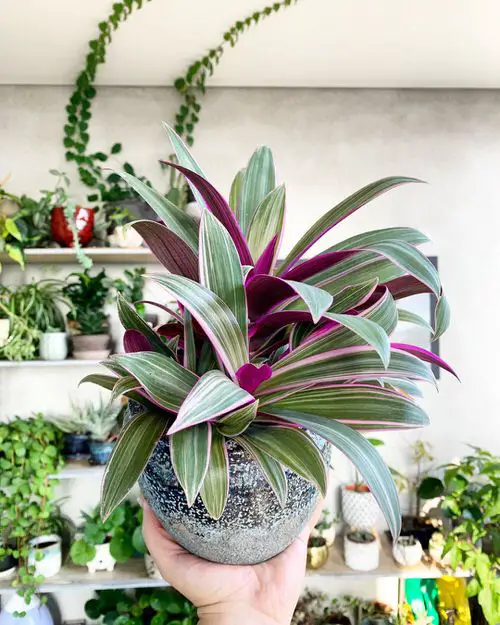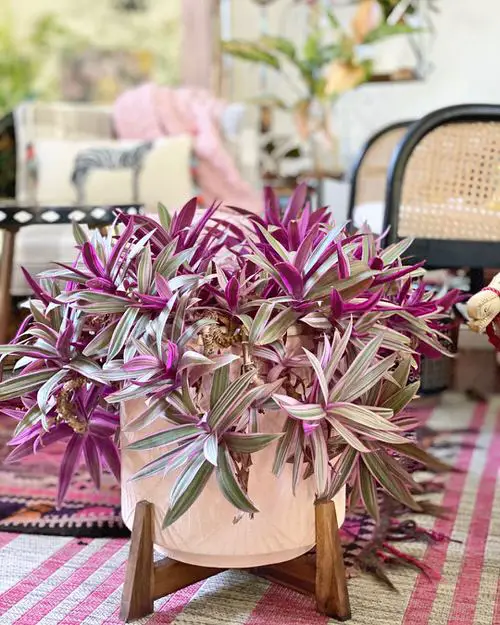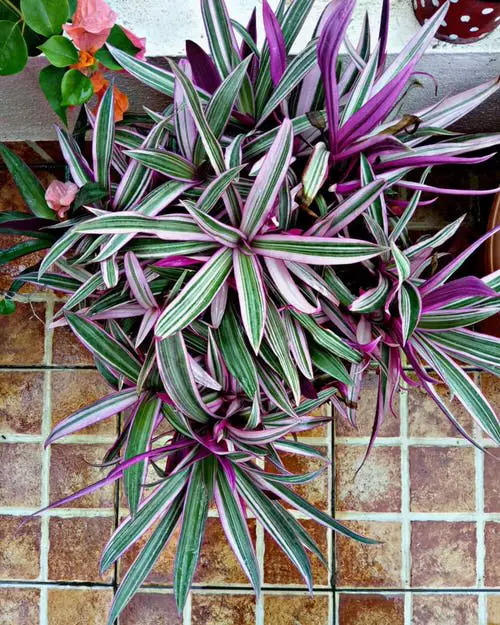Moses in the Cradle Plant Care Indoors is easy, and with the help of our guide, you will be able to display its beauty in your home all year!

The plant gets its name from boat-like bracts that uphold the beautiful white flowers gently growing in the middle. The best part is–it is also very easy to grow! Here are all the details about Moses in the Cradle Plant Care Indoors.
Botanical Name: Tradescantia spathacea
Common Names: Boat Lily, Moses-in-a-Basket, Moses-in-a-Boat, Cradle Lily, Oyster plant, Moses-in-the-Bulrushes.
Check out the most stunning purple houseplants here
Why You Must Grow Moses-in-a-Boat Plant?
Moses in the Cradle is one of the most versatile and easiest plants to grow and maintain in the flora kingdom, and this fact alone makes it worthy of grabbing a spot in your indoor plant collection. It also looks fantastic in vertical gardens, thanks to its growing habit, requirements, and tricolor foliage!
Propagating Moses in the Cradle Plant

There are two best ways to propagate Moses in the Cradle.
#1. By Division
Take out the plant from a pot and, using a clean knife, make sections of the rootball in a way where each division has roots and leaves attached to it. Once done, plant them in a well-draining potting mix.
#2. Stem Cuttings
Find a healthy plant and snip off 5-7 inches long stem cutting. Remove the lower foliage and plant in a potting mix, or submerge the cut end in water. Make sure it gets plenty of bright but indirect light. The roots will form in 4-6 weeks.
Have a look at the best wandering jew types here
Requirements for Growing Moses in the Cradle Plant

Light
This plant is very forgiving and tough. It doesn’t mind direct sun or being in low light, which means you can keep it anywhere. However, it grows best in a spot that receives bright indirect daylight. And for the best colors on the foliage, make sure it gets a mild morning or evening hours of direct sun every day.
Soil
The plant is not fussy when it comes to the growing medium and won’t even mind thriving in your regular garden soil. For the best results, the growing medium should be well-drained, crumbly, and rich in organic matter. You can use your usual houseplant soil mix you use for other indoor plants.
Watering
It is one of those plants that does not love to be watered frequently. Water only if the top of the soil feels dry to touch; for that–poke your index finger and feel the moisture. Also, avoid irrigating the plant from the top; otherwise, the water will accumulate in its center.
Temperature
Moses in the Cradle thrives best in average to warmer temperature ranges throughout the year–50-95 F (10-35 C).
It can also perform well in lower temperatures but does not appreciate when it gets colder than 41 F or 5 C.
Humidity
Again, the plant is not much demanding when it comes to humidity. During the drier days, you can move it to the kitchen or a bathroom as they are usually more humid places than the rest of the house or get a humidifier or place a pebble tray filled with water under the container.
Learn How to make a pebble tray for houseplants here
Taking Care of Moses in the Cradle Plant

Fertilizer
The plant does not need much feeding and pretty much manages on its own if you have topdressed the growing medium with some compost or aged manure during the start of the growing season. You can use a balanced liquid fertilizer to boost its growth, diluted to half of its strength, once in 8-12 weeks.
Pruning
Moses in the Cradle does not need pruning, but you can cut overgrown, dead, or damaged parts anytime to maintain desired shape and size indoors.
Pests & Diseases
The most common pests that could attack the plant are mealybugs, spider mites, scales, and aphids. Consider washing the plant under running water or the leaves with a solution— mixing 1 part of dishwashing soap, 1 part of neem oil with 5-6 parts of water.
The plant could also face some root rot issues if you keep it in a dark spot and water it consistently. It can also cause discoloring of leaves and stunted growth.


